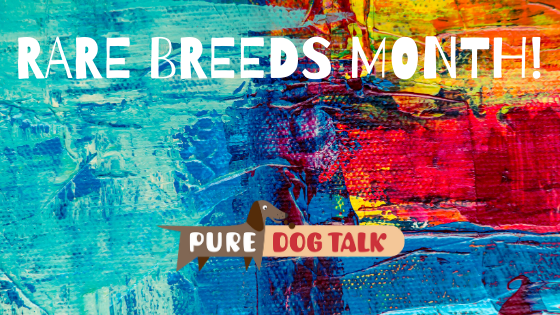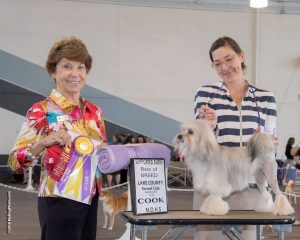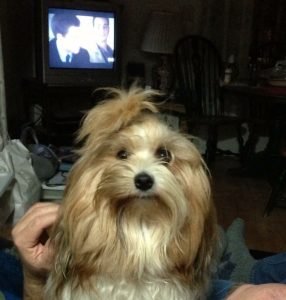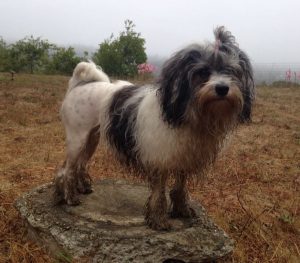381 – Rare Breeds: Preservation, Promotion and Purposeful Breeding
Rare Breeds: Preservation, Promotion and Purposeful Breeding
Let’s kick off a month of Pure Dog Talk conversations, insights and ideas about rare breeds, preservation, promotion and purposeful breeding of these delightful dogs.
Today’s conversation is with Jennie Chen, breeder of Lowchen and Greater Swiss Mountain Dogs, Anna Wallace, breeder of Entlebuchers and Ian Lynch, Dandie Dinmont Terrier owner.
How to acquire a rare breed dog
Just acquiring a dog in a rare breed is one of the most difficult challenges, our panelists agreed.
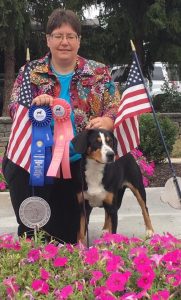
Anna Wallace and her Entlebucher
“I mean we’re absolutely protective of the dogs,” Wallace said. “So we have that aspect of ‘well we can’t keep them all we do have to place some of these puppies’ but we want to make sure they go into the right homes … can they benefit the breed in the long run… pets are very important because (they) become the ambassador the public sees … but we also don’t want to lose too much of our breeding pool in our gene pool to dogs that are going to ultimately end up neutered … so there’s a balance there and I know that’s one of the reasons it’s hard to break into (a rare breed). I actually broke in with a male ’cause it’s always easier to get a boy.”
Public education
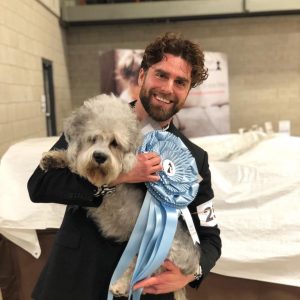
Ian Lynch with his Dandie Dinmont Terrier
Reaching the general public with information about our lesser known breeds is critical, especially younger people.
“I think a lot of times of millennials are kind of going back to our roots in a lot of ways,” Lynch said. “Like the farm to table eating, what’s old is new, what used to be called hand me downs is now called vintage clothing. I think a lot of people are really interested in history and I really liked the idea of being able to help a breed that needed a hand. I mean they say this in a lot of ways, that you could go to a shelter and you can save one dog or you can buy a rare breed, an endangered species. and save a whole breed of dog, the whole history of this dog can be saved.”
Social media

Jennie Chen with her Greater Swiss Mountain Dog and Lowchen.
Social media, particularly Instagram, including Facebook and Twitter, are great resources for reaching potential new owners. Our panelists agreed that young folks buy from social media and we need to reach potential owners where they are.
“I actually started in social media a little bit by accident,” Chen said. “’cause when I got my first greater Swiss mountain dog, I studied psychology and I’m all into early neurological stimulation early neurological training critical periods, I started *Keep Austin Dog Friendly… it is a list of restaurants in Austin TX where you could take your dog … I would go take my dogs out and I still do that today for socialization, for training and all that sort of stuff, and that website got really, really big … my dog became the face of *Keep Austin dog friendly… the website is still up … I even turned one of our website events into (my dog’s) birthday party … I use Instagram now quite a bit. A lot of my homes… create an Instagram specifically for the dog. I don’t have to get photos via email, they’re available all the time on my phone.”
Listen to the podcast for more insights, ideas and guidance from our outstanding panelists.
215 – Lowchen in Danger: Could be Extinct in our Lifetime
Ancient Lowchen breed holds threatened future
Alexia Rodriguez, breeder and Lowchen Club of America Director, talks about these non-shedding, healthy, active “best kept secret” little lion dogs. With depictions dating to the 1400s in Germany, Lowchen see only 80 dogs total registered annually in the U.S.
Rodriguez said that in 2015, only 18 litters of Lowchen were whelped in the US, with an average litter size of only three puppies. On its current path, the club estimates Lowchen could become extinct by 2044.
“Our numbers indicate only 37 percent of dogs in the U.S. contribute to the gene pool,” Rodriguez said. She added that the tight line breeding required to re-establish the breed following WWII is suspected to be the cause of the low litter numbers. Nonetheless they breed and whelp naturally.
Best kept secret
“The thing I love the most,” Rodriguez said, “is that Lowchen can be high level agility or performance dogs, and then they are just as happy to lay on the couch and snuggle for three days if you don’t want to do anything.”
Lowchen’s unique coat and “lion” trim is relatively low-maintence, Rodriguez said.
“You can go tracking one day, and the next day, give them a bath and blow out, and they’re ready to go in the ring,” she added. “If a smooth coated Cane Corso person can handle it, most people can…”
In German, Lowchen means “little lion dog” so they were shaved in the shape of a lion, Rodriguez noted. The trim includes “bracelets” on all four legs, with each leg shaved about half way, the body shaved from the last rib back and the tail shaved about half way up. No scissoring is allowed.
“They are tie- dyed dogs,” Rodriguez noted. “They come in all colors. Sables even look like a lion.”
The luxurious coat is not all one texture of hair, Rodriquez said. “Parti colors tend to be a little more curly and cottony,” she added. “White coats are the most difficult and tend to mat. Blacks and sables tend to have more easy to manage coats.”
Legends of the Lowchen
The breed was developed in Germany. One legend has it, Rodriguez said, that if a knight was killed in battle, they put a lion on his tombstone. If he died at home, they’d put a Löwchen on the tombstone.
The breed was rumored to be a favorite of the ladies of European royalty because the dogs would attract fleas and keep them off the people.
Living with the Lowchen
Weighing about 15 pounds, the breed is easy to travel with, Rodriguez observed, and very healthy.
“As a breeder we test eyes, hips, knees. There are not many heart problems. We test for PRA,” she added. “Breeders in the breed are very open, and willingly and publicly share information.”
These healthy little dogs will often live 17 to 18 years, Rodriguez noted. They are resilient and not at all fragile. In fact, Rodriguez commented that they are phenomenal in agility, where they mostly compete in the 12” class.
For more information or breeder referral, visit:
http://www.thelowchenclubofamerica.org/

